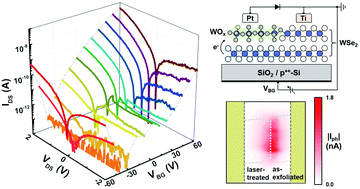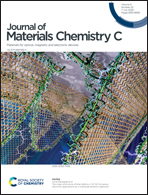An in-plane WSe2 p–n homojunction two-dimensional diode by laser-induced doping†
Abstract
Conventional doping schemes of Si microelectronics are inadequate for atomic-thickness two-dimensional (2D) semiconductors, which makes it challenging to construct 2D p–n homojunctions. Herein, a UV laser-assisted doping method with addressability is proposed for seamlessly building a 2D WSe2 p–n homojunction. WSe2 with ambipolar transport properties was exposed to a focused UV laser to form WOx in a self-limiting and area-selective process that induces hole doping in the underlying WSe2via electron transfer. Different electrical behaviors, ranging from p–p to p–n in-plane homojunctions, were observed between the as-exfoliated (ambipolar) region and the UV laser-treated (p-doped) region, under the electrostatic modulation of the back-gate bias (VBG), resulting in the multi-state rectification ratios of 895 (positive VBG) and ∼4 (negative VBG). The evolution of the depletion region in the WSe2 in-plane homojunction was analyzed at different VBG using the scanning photocurrent mapping approach, yielding a high photocurrent of 1.8 nA for positive VBG, owing to the development of the p–n junction. Finally, a WSe2-based 2D homogeneous complementary inverter is demonstrated with a voltage gain of 1.8, thereby paving the way for next-generation atomic-thickness circuitry.



 Please wait while we load your content...
Please wait while we load your content...